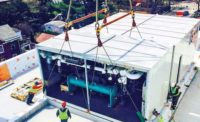New England Design Firms Keep A Steady Pace In Busy Market

Stantec, which was ranked No. 3 in ENR New England’s Top Design Firms list, is working on a development at the former Boston Globe headquarters.
RENDERING COURTESY OF STANTEC

Thornton Tomasetti, which was ranked No. 38, provided structural and facade engineering for Harvard’s District Energy Facility.
IMAGE BY LEERS WEINZAPFEL ASSOCIATES

No. 4-ranked WSP is serving as the owner’s rep for the Walk Bridge replacement project in Norwalk, Conn. No. 6-ranked HNTB Corp. is the engineer of record for the bridge, which is 60% designed.
IMAGE COURTESY THE CONNECTICUT DEPT. OF TRANSPORTATION



The results of the second-annual ENR New England Top Design Firms survey show that designers remain busy across the region. For example, Stantec’s Boston office is so busy that the firm is tapping employees from the firm’s other offices in New England and beyond to work remotely on projects in Massachusetts.
Stantec’s use of remote workers avoids costs associated with employee relocations and reflects the difficulties of attracting and keeping talent in such a tight labor market, says Peter Howe, the firm’s vice president and New England regional leader. “We have a great infrastructure and IT backbone that allows us to tap into talent in other spots in the company, which is great,” he says.
The survey’s 50 participating firms posted a combined $1.8 billion in revenue in 2017, the same total as the 52 qualifying firms logged in 2016. The lion’s share of that work was completed by the survey’s top 10 firms, which totaled a combined $1 billion in revenue both years.
AECOM tops the list again at $228.41 million, up from $221.71 million. Burns & McDonnell and Stantec remained in the Nos. 2 and 3 slots. Burns & McDonnell’s revenue weakened to $197.72 million from $199.34 million, while Stantec posted revenue of $120.78 million, down from $136.22 million in 2016. Despite the decrease, Howe is still pleased with the region’s overall growth. “We’ve been thinking things are going to slow down for a while and they haven’t been,” he says, “they just seem to be going the other way—which is great.”
The housing and office sectors are particularly strong, Howe says. Stantec is serving as lead architect for the BEAT at the former Boston Globe headquarters. The project will include nearly 695,000 sq ft of workspace, advanced manufacturing, co-working and entrepreneurial incubator space.
|
Related Link |
Transportation Leap
WSP leaped two spots in this year’s rankings to No. 4 with 2017 revenue of $111.91 million. The firm had $79.28 million in regional revenue in 2016. Like 16 other firms in this year’s ranking, WSP reported transportation as its top market sector in 2017. WSP was ranked No. 3 in the region in transportation with $69.86 million in revenue, or 62% of its regional revenue.
Jerry Jannetti, WSP senior vice president for the Northeast region, says New England’s transportation sector is “hopefully heating up in some areas and maintaining in others.”
While Massachusetts, Vermont, New Hampshire and Maine have maintained level funding for transportation, Jannetti has high hopes for Connecticut, where Gov.-elect Ned Lamont campaigned on a truck-only tolls system similar to Rhode Island’s to fund transportation projects. “I imagine after a new governor is in place we’ll hopefully see a refocusing on infrastructure,” Jannetti says.
WSP is serving as the owner’s rep for the $1.2-billion Walk Bridge replacement in Norwalk, Conn. The 122-year-old deteriorating swing-span rail bridge—a critical link in the Northeast corridor that carries approximately 200 trains across the Norwalk River each day—has failed to close properly several times. The new bridge, which is 60% designed, will be a vertical-lift bridge. “The warranty has run out on this thing over 100 years ago,” Jannetti says. No. 6-ranked HNTB Corp. is the project’s engineer of record.
In Massachusetts, STV, the No. 9 ranked firm with $53.03 million in revenue, is serving as the lead designer for the MBTA’s $1.3-billion Green Line Light Rail Extension. Service on the 4.3-mile extension through Cambridge, Somerville and Medford is expected to begin in 2021. The project also includes a new vehicle maintenance facility, administration building, viaduct, six new stations, one relocated station, six bridges and a community path. “The three communities where the Green Line Extension project is being constructed have been engaged in this process for nearly 20 years,” Mark Pelletier, STV vice president and Boston office manager, said in a statement. “They are knowledgeable, passionate and excited to have public transportation being made available to them.”
Affordable Education
The education sector continues to be strong in New England as 33 firms reported a combined total of $119.19 million in revenue. Thornton Tomasetti Inc., which was ranked No. 38 on the overall list both last year and this year, provided structural and facade engineering services for the Harvard University District Energy Facility. Scheduled for completion in summer 2019, the project was designed to be one of the most energy-efficient laboratory buildings of its size through the use of heat-recovery systems and a 1.3-million-gallon tank for storing chilled water for cooling buildings. By storing and producing chilled water when electricity is cheaper and less-polluting during off-peak hours, the tank will allow the facility to reduce its reliance on the power grid by using the chilled water during peak hours.
Despite a robust education sector, the Boston area’s skyrocketing housing costs mean many graduating students can’t afford to stay in the area. That’s one reason why 15 members of the Metro Mayors Coalition in October called for a regional goal of creating 185,000 new housing units by 2030.
Howe says the affordable housing initiative could help increase Boston’s pool of young engineering talent. “That’s the biggest challenge,” Howe says. “Everybody wants to be in Boston, but being able to afford to live there is really the question.”







